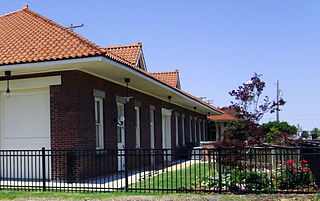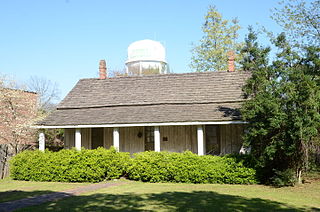
The University Cottage Club or simply Cottage Club is one of eleven current eating clubs at Princeton University, in Princeton, New Jersey, United States. It is also one of the six bicker clubs, along with The Ivy Club, Tiger Inn, Cap and Gown Club, Cannon Club and Tower Club.

Located near Dardanelle, Arkansas and rising 1,350 feet (410 m) above the mountain valleys of west central Arkansas, Mount Nebo has a view of 34,000 acres (140 km2) Lake Dardanelle, the Arkansas River and the surrounding mountain ridges. Atop this biblically named plateau, fringed by the Ouachita National Forest, is Mount Nebo State Park. Developed as a resort area in the late 19th century, it became a state park in 1928, its early development spearheaded by the Civilian Conservation Corps. Park activities include hiking, camping, and other outdoor pursuits.

The Eureka Springs Historic District is a historic district that was listed on the National Register of Historic Places in 1970. Its boundaries are those of the city of Eureka Springs, Arkansas at the time of its listing, specifically augmented in 1979 to include its historic railroad depot. Much of the city was developed between 1880 and 1910, when the area was the center of resort activity taking advantage of the many natural springs in the area. About 20% of the city's buildings were built in the 1890s and have a significant element of either Queen Anne or Second Empire styling, while its commercial buildings tend to have Romanesque and Italianate details. The city is one of the best-preserved turn-of-the-century resort communities in the region.

The Yell Masonic Lodge Hall is a historic Masonic lodge on the west side of United States Route 412 in Carrollton, Arkansas. Also known as Carrollton Masonic Lodge, it is a two-story wood-frame structure with a front-gable roof, clapboard siding, and a stone foundation. A small belfry rises above the roof, capped by a pyramidal roof. The building was built in 1876, originally serving as a church on the ground floor, and a Masonic meeting hall on the second. The building was a major community center for Carrollton, which was the first county seat of Carroll County but declined in importance after it was bypassed by the railroads.

The Cottage Home Historic District is a historic district and neighborhood located on the near east side of Indianapolis, Indiana. A small portion of Cottage Home is listed on the National Register of Historic Places while a larger area is listed on the state and local levels. Known for its preponderance of "cottage-style" homes built with strong Victorian influences, Cottage Home has historically been a working class neighborhood. Numerous industrial buildings are also scattered throughout the district, providing a base of economic activity. Today, however, many of these buildings are vacant, providing a special challenge to preservation and urban renewal efforts.

Union Station is a former railroad station at East 4th Ave. and State St. in Pine Bluff, Jefferson County, Arkansas. The station was originally at the union of the Cotton Belt and Iron Mountain railroads, and now houses the Pine Bluff/Jefferson County Historical Society museum. It is a single-story brick building, with a hip roof whose long eaves are supported by iron columns and half-truss brackets. The station was built in 1906 by the Iron Mountain Railroad. It had been a stop on the St. Louis Southwestern's Lone Star (Memphis-Dallas), and also on the railway's St. Louis-Dallas trains.

The Missouri Pacific Railway Van Noy Eating House is a historic restaurant building at the corner of Seamans Drive and Railroad Street in McGehee, Arkansas. The single story brick building was constructed c. 1910 by the Missouri Pacific Railroad, and housed a dining establishment operated by the Van Noy Railway News and Hotel Company. It is one of a small number of such buildings to survive in the state. The building was divided into three parts: a central kitchen served a lunch counter area on one side, and a dining room on the other. The establishment closed in 1948.

The Dr. A. G. Anderson House is a historic house located at the junction of Duncan and Main Streets in Eudora, Arkansas.

The Cotton Belt Railroad Depot is a historic railroad station at the junction of Main and 1st Streets in downtown Fordyce, Arkansas. The single-story brick building was built c. 1925 by the St. Louis Southwestern Railway, also commonly known as the Cotton Belt Railroad. The building is predominantly Craftsman in its styling, with extended eaves that have elaborately styled brackets.

The Missouri-Pacific Railroad Depot-Gurdon is a historic railroad station building at North 1st Street and East Walnut Street in Gurdon, Arkansas. The single-story masonry building was built c. 1917 by the Missouri-Pacific Railroad to house passenger and freight service facilities. It is built in the Mediterranean Renaissance style which was then popular for building such structures in Arkansas. It has a red clay tile roof, Italianate bracketing, and Baroque quoin molding.

The Missouri and North Arkansas Depot is a historic railroad station at Center Street and Cash Streets in Bellefonte, Arkansas. It is a small single-story structure with a wide low-pitch gable-on-hip roof and a rubble-stone exterior over a wood frame. A small shed-roof addition enlarges the building slightly to the north, while a larger cross-gable addition projects from the rear. It was built in 1901 by the Missouri and North Arkansas Railroad to serve the area's passenger traffic. It is a rare example of rubble-over-frame construction for railroad stations in the region.

The Peter Smyth House is a historic house at 1629 Crossover Street in Fayetteville, Arkansas. Built in 1886, it is a regionally rare example of a small stone cottage built in a traditional central hall plan. The house is built out of coursed sandstone, and has finely-chiseled lintels and sills for the openings. The front facade is five bays wide, with a center entry flanked by four sash windows. There two chimneys just inside the outer side walls at the peak of the side gable roof. A stone ell of antiquity similar to that of the house is attached to the rear; it is uncertain whether it was built as an integral part of the house, or added later.

The Cottage Courts Historic District encompasses a historic travelers' accommodation at 609 Park Avenue in Hot Springs, Arkansas. Built about 1950, it was one of the first motel-type tourist accommodations to be built in the city. Unlike earlier tourist courts, which typically had idiosyncratic vernacular architecture, Cottage Courts consists of two ranch-style single-story buildings, one of which houses twelve guest rooms, and the other three plus the operator's apartment and office.

The Miller House is a historic house at 1853 South Ringo Street in Little Rock, Arkansas. Built in 1906 and twice enlarged by the same owner, the house is a reflection of the effect of segregation in the United States. Now a two-story brick-faced Craftsman-styled structured, it was originally built as a modest single-story cottage typical of the segregated African-American neighborhood in which it was located. It was purchased in 1924 by Arthur T. Miller, who was employed in a comparatively secure position as a railroad mail clerk. Prevented by segregation from moving to more affluent neighborhoods, Miller chose to enlarge the house, and then finish it in brick.

The former Rock Island Depot is a historic railroad station at the junction of Front and Center Streets in downtown Lonoke, Arkansas. It is a long, rectangular brick building, topped by a steeply-pitched gabled tile roof. Its gable ends are partially stepped and raised above the roof pitch in the Jacobethan style. It stands south of the area where the Rock Island Line railroad tracks ran, and has a three-sided telegrapher's booth projecting from its north side. It was built in 1912, and served as a passenger and freight station for many years, and now houses the local chamber of commerce.

The Thornton House is a historic house at 1420 West 15th Street in Little Rock, Arkansas. It is a two-story wood frame American Foursquare house, with a dormered hip roof, weatherboard siding, and single-story porch across the front. Its roof and dormer have exposed rafter ends in the Craftsman style, and the porch is supported by fluted square columns, with spindled balustrades between. The oldest portion of the house is a small cottage, built about 1896 and subsequently enlarged several times. It is prominent as the home in the early 20th century of Dr. John Thornton, a prominent African-American physician, and also briefly of Charlotte E. Stephens, the city's first African-American teacher.

The Shaheen-Goodfellow Weekend Cottage, also known as Stoneflower, is a historic house at 704 Stony Ridge Road in Eden Isle, Arkansas, a resort community on a peninsula jutting into Greers Ferry Lake west of Heber Springs. It is a distinctive Modern structure, designed by Arkansas architect E. Fay Jones and completed in 1965. The main structure is a relatively small rectangular wood frame structure, given vertical emphasis by its placement at the top of a slope and vertical board-and-batten siding. On the lake side of the house a wooden deck projects from the upper level, with vertical railing elements and an outdoor cooking area built in. The house is a clear predecessor to one of Jones' signature works, Thorncrown Chapel, with which it shares design and construction methods, albeit in a smaller scale.

The Van Frank Cottages are a collection of four small houses at 515-519 East 15th Street and 1510 Park Lane in Little Rock, Arkansas. All are modest single-story single-family buildings with high quality Colonial Revival details. They were built in 1908 for Philip R. Van Frank, a civil engineer who played a major role in the management of the waterways in the Little Rock area, overseeing the construction of locks and dams on the Arkansas and White Rivers. They are the only known buildings associated with Van Frank's life.

The Ward-Hays House is a historic house at 1008 West 2nd Street in Little Rock, Arkansas. It is a two-story brick building, distinguished by a massive front portico, with two-story fluted Ionic columns supporting an elaborate entablature and cornice. The house was built in 1886 for the son of Zeb Ward by prison labor provided by the Arkansas State Penitentiary, which Ward headed at the time. Its second owner was John Quitman Hays, a prominent railroad engineer.




















